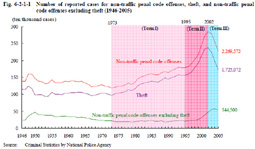| Previous Next Index Image Index Year Selection | |
|
|
1 Reported cases for non-traffic penal code offenses
Fig. 6-2-1-1 shows trends in the number of reported cases for non-traffic penal code offenses, theft, and non-traffic penal code offenses excluding theft since 1946.
Fig. 6-2-1-1 Number of reported cases for non-traffic penal code offenses, theft, and non-traffic penal code offenses excluding theft (1946-2005) The number of reported cases for non-traffic penal code offenses remained around 1.4 million cases since the early 1950s, after the post-WWII confusion. The number decreased in the late 1960s and marked a record low at 1.19 million cases in 1973, but was on a moderate upward trend from 1974, repeating ups and downs every year. In recent years, after showing a slight decrease from the previous year in 1995, the number continued to increase significantly from 1996, marking a post-WWII record at nearly 2.85 million cases in 2002. However, it started to decrease in 2003, and was nearly 2.27 million cases in 2005 (see Part 1, Chapter 1, Section 1, 1).In this Chapter, criminal trends including the number of reported cases for non-traffic penal code offenses will be analyzed by dividing the period since 1973, when the number was the lowest after the war, into three parts. Trends in each part of the period are outlined as follows. (1) Term I (between 1973 and 1995) Term I is between 1973 and 1995, which was the last year that registered a slight decline from the previous year. This is the term just prior to the start of increase towards 2002, when the number marked a post-WWII record. During this term, the number of reported cases for non-traffic penal code offenses increased by nearly 0.59 million cases. Meanwhile, the number of reported cases for theft increased by nearly 0.6 million cases, almost the same as the total increase of the term. The number of reported cases for non-traffic penal code offenses excluding theft has remained almost flat. (2) Term II (between 1996 and 2002) Term II is between 1996 and 2002, when the number marked a post-WWII record. Between 1995, the final year of Term I, and 2002, the number of reported cases for non-traffic penal code offenses increased by nearly 1.07 million cases, while the number of reported cases for theft increased by nearly 0.81 million cases, accounting for about 75% of the total increase of the term. Unlike in Term I, the increase in the number of reported cases for non-traffic penal code offenses excluding theft took up a certain proportion in the total increase. Non-traffic penal code offenses excluding theft started to increase in number significantly from 2000, in particular. (3) Term III (between 2003 and 2005) Term III is between 2003 and 2005, when the number of reported cases started to show a sign of decrease. Between 2002, the final year of Term II, and 2005, the number of reported cases for non-traffic penal code offenses decreased by nearly 0.58 million cases, while the number of reported cases for theft decreased by nearly 0.65 million cases, whose decrease was larger than the total decrease. On the contrary, non-traffic penal code offenses excluding theft increased during this term, continued to increase until 2004, hitting a peak in the same year, and showed a slight decrease in 2005. |
